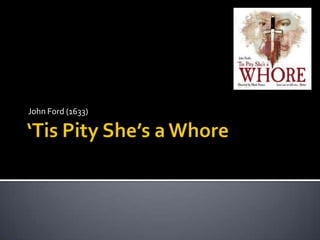Tis Pity
- 2. John Ford (1586 – 1640) is often considered to be the last of the great Renaissance dramatists. ‘Tis Pity She’s a Whore is his most famous work, bringing him much critical acclaim. Based on the story of the incestuous relationship between Annabella and her brother Giovanni, it incorporates many features of a Jacobean tragedy, though it was written when Charles I was on the throne.
- 3. The play is noted for its dark, macabre tone and celebrated for the strikingly dramatic and bloody conclusion, but its real strength lies in its challenging presentation of the couple. Ford presents the lovers in a compassionate manner and at times seems keen to engage the audience’s sympathies even though their relationship, in either his own society or modern ones, would be considered illegal and unhealthy (unless you’re Annabelle).
- 4. This sympathy often stems from comparisons with other characters in the play as it seems that nobody is free from guilt and those we would expect to be most virtuous (religious figures etc) are shown to be the most corrupt. In the extract, the function of which is to first introduce the relationship between the two lovers, we are led to empathize with their plight as they wrestle with their illicit emotions.
- 5. There is a sense of despair here and the repetition makes the line like a lament. This immediately engages the audience and creates sympathy for the character.
- 6. The repetition of the personal pronoun indicates that Giovanni acknowledges some responsibility as well as blaming the fates, but the vocabulary is dark, suggesting the inevitability of tragic consequences for the relationship.
- 7. The cyclical nature of these lines reflects Giovanni’s confusion and distress. The contrast between strive and love, coupled with the reference to a loss of hope, is also striking, as it is usually thought that love should by contrast bring pleasure and optimism. This illustrates the doomed nature of the relationship and shows how aware he is of his and his sister’s likely fate. Again, Ford is creating sympathy for the lovesick Giovanni.
- 8. Giovanni is conscious of his destiny. The audience will be expecting a dark conclusion to the tragedy.
- 9. The use of phrases associated with illness suggests that his passion is something natural and uncontrollable.
- 10. The phrase is again associated with hopelessness.
- 11. Beginning the line with ‘O’ adds to the sense that this is a soliloquy of lament.
- 12. Ford establishes an extended metaphor here, comparing the relationship with religious images. This serves two purposes: first, it makes the audience aware that Giovanni considers the relationship to be something beautiful and worthy of admiration; second, it reminds us of the fact that the lovers will be punished not only on earth by God too, a theme central to the play as a whole.
- 13. The verb wearied echoes the frustration that has been established. The fact that Giovanni is turning to God again reflects the religious theme of the play and could create sympathy.
- 14. How might this natural image affect the audience’s view of Giovanni?
- 15. Phrases associated with hunger suggest his sexual appetite, and also link to the image of the spring earlier, suggesting his love is natural and uncontrollable.
- 16. The juxtaposition of young and old here reminds us of Giovanni’s impulsive youthfulness, and the premodifier unsteady adds to this. The contrast also illustrates the young love being condemned by the elders and old rules.
- 17. This second reference to fate not only suggests that it is destiny that is driving the lovers together but argues that Giovanni’s feelings are not driven solely by his sexual desires.
- 18. This stark and direct statement creates a sense of anticipation as the audience await his revelation. How does this impact on our view of the lovers?
- 19. The reference to monetary value reminds us of the price of love.
- 20. The exclamation reflects Giovanni’s excitement but also fear of what he is about to do.
- 21. This aside illustrates Giovanni’s anxiety but also creates sense of anticipation.
- 22. The simple exchange emphasizes their relationship as that of brother and sister as well as, once again, developing the relationship between the couple and the audience.
- 23. Again referring to their love as a sickness, and suggesting that his suffering is physical as well as emotional.
- 24. This can be seen as an uncomplicated, beautiful meeting of brother and sister, walking hand in hand. The audience is therefore able to develop a bond with them prior to the revelation of their incest later in the play.

